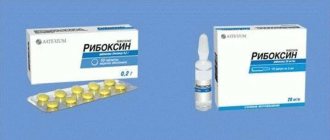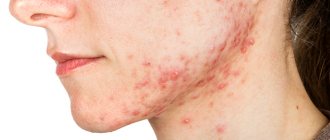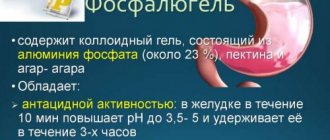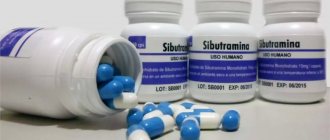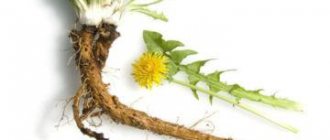The golden cap of the dandelion serves as a symbol of the sun and light, and the scattering seeds speak of change and the transience of life. At the slightest breeze, fluffy umbrellas break away from the stalk. In clear weather, the yellow dandelion rejoices in the sun along with people, but as soon as the sky frowns, it covers itself with petals, warning of bad weather and protecting its pollen from the rain. If the sun is shining, you can use it to check the time; it opens and closes at the same hours. Dandelion: medicinal properties and contraindications
Many superstitions and beliefs are associated with dandelions; talismans are still made from them. Girls braid dandelions into wreaths with the hope of family happiness, float these wreaths along the river and make a wish: whose wreath does not drown, she will be the first to get married. A love potion is brewed from dandelion roots, and dandelions are placed under children's beds to protect them from black eyes.
The healing properties of a simple dandelion
Treatments for rheumatism
First, you need to eat dandelion stems, they need to be eaten raw - as much as the body allows, so as to feel comfortable. It is best to eat the stems on the third day after the flower is released, when the stems become slightly brownish and contain a lot of healing juice. To get rid of the disease you need to consume the stems throughout the season, often this is enough.
The second is an auxiliary remedy: collect and immediately grind dandelion flowers, mix them with sugar in a 1:1 ratio, place them in an open place, but in the shade, for one day, then put them in the refrigerator. After 1.5 weeks, squeeze out the contents and strain. Keep refrigerated. Use arbitrarily, the more, the better. This will not cause harm (restriction is only for those who should not consume sugar).
Eating the stems will also be useful for those who have vasoconstriction or coronary heart disease - from 5 to 10 pieces in the morning on an empty stomach 2 hours before breakfast, chewing thoroughly.
Painful joints with arthritis and polyarthritis can be treated with dandelion flowers. To do this, pick 10 pieces daily, chew them thoroughly into a pulp and swallow. For those who have these diseases in a chronic form, dry the flowers for the winter, then steam them with boiling water and eat 1 tbsp. per day in the morning on an empty stomach.
Joint pain. Rubbing tincture of dandelion flowers on triple cologne, infused for 10-12 days, gives a lasting analgesic effect. To do this, collect flowering dandelion heads, place them tightly in a jar, and fill them with triple cologne. They insist, then filter.
If you have problems with the thyroid gland, you need to add a little seaweed, parsley root or greens, boiled beets and season with vegetable oil to the dandelion leaves. This will be such a strong source of iodine for the body that the patient’s condition will definitely improve.
The large amount of magnesium contained in this plant helps in the treatment of the nervous system, heart, and increases the level of hemoglobin in the blood.
Healing dandelion honey
This honey can treat joint diseases, get rid of gallstones and kidney stones, joint pain, pain in the fingers, improve metabolism, cure osteochondrosis, put in order the main filters of the body - the liver and kidneys. This honey should be consumed within 2 years, although some people find it helpful within one year.
To prepare dandelion honey, flowers should be collected during the first mass flowering, choosing an environmentally friendly place for this purpose, at least 2-3 km from busy highways, in order to avoid heavy metal salts. For one person for a year (from dandelions to dandelions) you need 3 liters of honey. There are several recipes for making dandelion honey, each of them is useful.
Recipe 1. For 1 liter of honey, collect 350 dandelion flowers along with a green base in the form of a basket, without stems. Rinse the entire flower mass thoroughly with cold water and pour in 1 liter of cold water, put the container on the fire, bring the mass to a boil and cook over low heat for 1 hour with the lid closed.
Place the flowers in a colander and when all the liquid has drained, throw them away. Pour 1 kg into the resulting green broth. sugar, bring to a boil and cook again for 1 hour over low heat. 15 minutes before the end, squeeze in the juice of one lemon. Let the liquid sit until the next morning. The honey is ready.
You should take it 1 teaspoon three times a day.
Recipe 2. Fresh dandelion flowers 200 pcs, place in portions in a sieve, rinse thoroughly with cold water, let it drain. Place all the flowers in a saucepan and add 1 lemon, wash it thoroughly, chop it coarsely and mix it with the flowers in the saucepan. Pour 500ml. water and cook for 10 minutes. over low heat, stirring occasionally. Remove from heat and leave to stand for 24 hours. Then strain the mixture and squeeze well.
Discard the flowers and add 750g to the remaining liquid. sugar, bring to a boil with constant stirring and cook for 30 minutes. over medium heat. Prepare jars and lids. They need to be washed well and doused with boiling water. Fill the jars with hot jam and immediately close the lids. Place upside down and let cool.
Recipe 3. 400 dandelion heads, 1 liter of water, 1 kg of sugar. There is no need to wash dandelions, otherwise the pollen will be washed off. Place dandelion heads in a saucepan and add hot water. Let them sit under the lid until the water cools down. Strain, add sugar and cook for 20-30 minutes. When the jam boils, a white scum will appear. It needs to be removed. Pour into prepared jars. For sourness, you can add lemon juice to the jam (just before removing from the stove).
Recipe 4. 400 pieces of dandelion flowers without stems.
Rinse in cold water and leave in it for a day (you can change the water several times during the day). After a day, squeeze out the flowers and pour out the water. Boil 1/2 liter of water and place flowers in boiling water. Boil for about 15 minutes (over low heat). Squeeze well. Discard the flowers, add 1 kg of sugar and the juice of 2 lemons to the remaining water. Cook over low heat, stirring continuously for 50-60 minutes. until the color and viscosity of honey. If after an hour your honey has not thickened, cook for another 20 minutes. You should get about 1 liter. The honey turns out to be very tasty, aromatic and of course healthy. It must be stored in the refrigerator.
WARNING
This honey should not be consumed by children under 19 years of age until the growth of the body’s skeleton, and with it the formation of bones, has finished, otherwise dandelion honey can damage young bone tissue that has not yet formed.
Dandelion roots are the strongest and most valuable part of the plant. In folk medicine, extracts, extracts, and infusions from dandelion roots are used for various diseases: spleen, pancreas and thyroid gland, hyperacidity, inflammation of the lymph nodes, constipation, furunculosis, rashes. Dandelion root powder heals wounds, burns, and ulcers.
The roots can be harvested in early spring at the beginning of regrowth, but even better in the fall, 2 weeks after the flowers have faded and the seeds have flown around. In autumn, the root accumulates much more nutrients.
The plants are dug up with shovels, the soil is shaken off, the remaining leaves, root tip, root collar and thin lateral roots are cut off. After this, they are washed in cold water and dried in air for several days until the milky juice ceases to be released from them.
The roots are then dried in well-ventilated attics or under sheds, spread in a thin layer on paper or fabric. Can be dried in ovens or dryers at a temperature of 40-50 ° C. The raw material should consist of slightly branched roots without a root collar, 2-15 cm long, longitudinally wrinkled, sometimes twisted, brown or dark brown on the outside. Inside, on the break, there is yellow wood. There is no smell. The taste is sweetish-bitter with a mucous sensation.
Dandelion roots, collected in May and ground into a paste, are applied to tumors on the breasts of women for their speedy resorption and to hardening on the lymph nodes under the armpits and in the groin . The same gruel is used to treat hemorrhoids and stop uterine bleeding (the gruel is wrapped in gauze and tampons are placed).
It is useful to use a decoction of dried autumn dandelion root for anorexia of various etiologies, anacid gastritis, hepatitis and inflammation of the gallbladder.
Dandelion root decoction recipe
1. Crushed dried roots: 10-20 g per 200 ml of water. Cook for 10 minutes. Take 1 tbsp. before eating.
2.Chopped dried roots: 2 tsp. cook for 10 minutes in a glass of water. The decoction is taken orally in half a glass 2 times a day 20 minutes before meals.
By autumn, dandelion accumulates natural polysaccharides. Autumn roots contain up to 40% inulin, a natural relative of insulin, which makes them a valuable remedy for diabetics.
For diabetes, use a salad made from raw autumn roots, as well as coffee from the root, previously dried, fried in a frying pan, and then ground into powder 1 tsp. powder per glass of boiling water.
As a choleretic agent: pour three tablespoons of crushed dandelion roots into 2 cups of boiling water, boil for 20 minutes, filter. Take 1 glass orally 2 times a day.
For eczema: a mixture consisting of a tablespoon of crushed dandelion roots and the same amount of burdock leaves, pour 3 glasses of water, leave for 8-10 hours, boil for 10 minutes, filter when cooled. Take half a glass orally 5 times a day. It is advisable to simultaneously apply this decoction externally.
To increase appetite, for constipation, as a choleretic agent: 1 tsp. finely chopped dry root is brewed like tea in a glass of boiling water, infused for 20 minutes, cooled and filtered. This infusion is taken half an hour before meals, 1/4 cup 3-4 times a day.
Treatment of epilepsy: for this, a vodka tincture is made: pour 2/3 cup of the roots into 0.5 liters of vodka, leave for 2 weeks in a dark place, shake periodically. Take 1 tbsp. 3 times a day before meals.
For atherosclerosis of cerebral vessels, to remove cholesterol, toxins and waste from the body. To do this, drink 1 tsp of powder from crushed dry dandelion roots. 3 times a day before meals.
Eating raw dandelion roots (especially when mixed with raw, grated burdock root) stops the growth of cancerous tumors.
Dandelion flower oil is a medicine with fantastic healing power.
Dandelion flower oil will help with liver diseases and gallstones, with frequent constipation, as a choleretic agent, and any problems with the gastrointestinal tract (gastritis, colitis). You need to take it 1 tbsp. l. 3 times a day before meals or during meals.
Using dandelion flower oil, you can treat many skin diseases, old wounds, scars, burn marks, eczema, psoriasis, erysipelas, impetigo (superficial pustular skin disease). They are treated by applying linen napkins soaked in this oil to the affected areas.
Recipe for making dandelion oil:
Collect dandelion flowers along with flower stems in dry, sunny weather. This mass is ground until the juice appears and glass jars are laid out, filling them halfway. Then fill it to the top with fresh vegetable oil (any kind), tie the necks with gauze and take it out in the bright sun all day. After 3 weeks, filter, squeeze and store in a dark place at room temperature.
Dandelion juice
It is used to improve vision, for osteochondrosis, osteomyelitis, and ankylosing spondylitis. For periodontal disease, you can use a medicinal cocktail: 2/3 tbsp. carrot juice, 3 tbsp. dandelion juice, 1 tbsp. honey, and add black radish juice to the top of the glass. Drink on an empty stomach once a day in the morning.
Description
Dandelions grow almost everywhere: in forest belts, in fields, near houses and railways, in gardens and on lawns. The exception is some high mountain areas, deserts and the Arctic. Climatic and edaphic (soil) conditions in these areas are not always suitable for dandelions.
This wild plant has many names among the people:
- roadside;
- Jewish hat;
- hollow grass;
- Kulbaba;
- baldhead;
- milky color;
- kupava;
- air flower;
- Russian chicory;
- tooth root;
- jaundice;
- wild spurge;
- field dandelion;
- March bush;
- cotton grass;
- milk pan;
- medicinal dandelion;
- blind man;
- Kulbakha and others.
This once again proves the enormous popularity of this bright yellow beauty.
Information: About 1000 species of sunflower are known. On the territory of the Russian Federation you can find - 208.
All types of dandelion practically do not differ in appearance from each other. Various features can be traced only in the shape of the root system, leaves and the structure of the achenes. In Russia, the most common species is dandelion.
Botanical characteristics
Dandelion officinalis is a hardy herbaceous perennial plant that can grow in almost any environment. It requires no maintenance. Tolerates drought and low temperatures well. The height of dandelion can reach 50 cm.
Root system
The thick, slightly branched taproot of dandelion can reach a length of 20-60 cm and a diameter of 2 cm.
The rhizome of the wild plant is short. An arrow (flower stem) extends from it, at the top of which there is one basket of a sunny flower. Unlike old rhizomes, which are capable of producing several unbranched arrows 5-60 cm high, young ones can “release” only one.
Leaves
Numerous leaves of dandelion can reach a length of 10-25 cm and a width of 1.5-5 cm. They are collected in a rosette. Toward the base, the leaves narrow and form winged petioles.
This is interesting: In dry weather, dandelion leaves are small, but in humid summers they are juicy and large.
For different types of sunny wild plants, the size and shape of the leaves may differ. You can find giant dandelions.
The leaves of such representatives of the flora can reach a width of 15-20 cm and a length of 50 cm. The plant grows to such dimensions thanks to constant nutrition using grooves located on the leaves. All the water flows through them to the roots and protects them from drying out.
Flowers
The flowering of dandelion begins in early spring. Ends at the end of August. Mass flowering occurs in May. Sometimes you can see sun caps in the fall: in early and mid-September.
Photo: Dandelion flowering cycle
The development of a flower bud occurs at a depth of 3-5 cm underground. Gradually it rises up, breaks through the soil on the arrow and turns into a beautiful bright sunny flower.
Golden-yellow reed inflorescences of dandelion officinalis are collected in a large basket with a diameter of 3-6 cm.
Before rain and after sunset (closer to night), in order to preserve pollen, the flowers of the plant close. In sunny, clear weather, the dandelion is always open.
Seed fruits
The spindle-shaped fruits and seeds of the dandelion are presented in the form of tufts-parachutes of soft, thin white hairs. They are located in the receptacle in the form of a fluffy ball.
Fruit ripening occurs in June-August. Quite often the plant can re-bloom and bear fruit throughout the summer season.
Reference: More than 150 achenes are formed on one inflorescence. And the number of all fruits on a dandelion can reach 2500-3000.
Dandelion is propagated by:
- vegetative method (roots, leaves);
- seeds.
Thanks to the lightness of the parachute tuft, the fruits of dandelion are easily torn from the basket and carried by the wind over long distances from the mother plant (from 50 meters or more).
Chemical composition
The chemical composition of dandelion is very impressive. It contains a large number of chemicals, as well as micro- and macroelements beneficial to the body.
| Plant part | Chemicals, micro- and macroelements |
| Root |
|
| Leaves and inflorescences |
|
| Pollen |
|
How to prepare and preserve dandelion juice.
Recipe 1.
The entire plant, along with roots, leaves and flowers, is passed through a meat grinder and the juice is squeezed out through cheesecloth. To preserve it, add 100 g of alcohol or 400 g of vodka to 0.5 liters of the resulting juice and pour it into sterile jars.
Recipe 2.
Add 150 ml of vodka to 700 ml of juice. Place in a cool place. After a while, the juice will turn a little sour, but there is no need to be afraid of this. Lactic acid formed during weak fermentation improves the quality of the juice. It has a good effect on the digestion process and inhibits putrefactive processes in the esophagus, and is also an anti-cancer agent.
Recipe 3.
Dandelion flowers need to be collected in the morning, in sunny time, when the field breathes the dandelion aroma and the dew has already dried, then the main values of the inflorescences are in full set. Immediately take with you to the field a three-liter glass jar, 1-1.5 kg of sugar and a clean wooden stick. Pluck the blossoming inflorescences, choosing the most lush and largest ones.
Place them in a jar and cover with sugar. And so on in several layers. Fill the jar halfway and tamp it all down with a wooden stick, pressing well but carefully. You can add a few drops of water.
Then fill the jar again in layers and compact it tightly again until the juice that begins to stand out fills the entire jar. It will be juice, brownish in color, slightly bitter, but pleasant to the taste. You need to let it sit for a while, then drain it and squeeze out the remaining mass. Due to the high sugar content, the product can be stored in a cool place even until the new season. You can take 1 tsp. per day in pure form or added to tea or juices.
CAREFULLY! Dandelion can cause loose stools (mainly by increasing the secretion of bile). Therefore, the grass and roots of the plant are not used for gastrointestinal disorders.
It is undesirable to take dandelion preparations for severe hypotonic dyskinesia of the gallbladder, since excessive flow of bile into the gallbladder, which lacks contractility, will contribute to its stretching and increased pain. You should not use dandelion for allergic dermatitis, since dandelion flowers and their pollen can cause an allergic reaction. If you have flu-like symptoms, dandelion treatment should be discontinued.
Healthy salad recipes
For salads, dandelion leaves are used only during the flowering period; after the dandelion has faded, there is no point in collecting them. Young leaves in spring have almost no bitterness, are tender and more suitable for salads; summer leaves are best soaked in water to remove the bitterness. You can soak them for 30-40 minutes in a saline solution, then the bitterness will decrease significantly.
A salad of fresh leaves and dandelion root powder lowers the amount of cholesterol in the blood.
It is better to season dandelion salad with mayonnaise or sour cream. Boiled potatoes, beets, peas, onions, carrots, vinegar, chopped egg, garlic, dill are also added there. You can use a dressing made from vegetable oil, vinegar, sugar, salt, ground pepper and water for dandelion salads.
May salad
100 g of dandelion leaves, the same amount of green onions and 50 g of parsley or celery, boil one egg, season with sour cream, salt and add 1 teaspoon of sugar dissolved in a tablespoon of 5% vinegar.
Salad with lungwort
take equal parts dandelion and lungwort leaves. Chop, add onion, chopped parsley, or dill, or caraway seeds, sprinkle with salt and mash so that the plants release juice, season with vinegar and vegetable oil or sour cream.
Side effects
Dandelion, collected from a favorable, clean region, is a safe, non-toxic plant. It does not pose a threat if eaten fresh or processed.
Considering that dandelion contains a lot of active substances, we can assume the risk of allergic reactions. This is especially likely for people who are allergic to any plants, such as ragweed. In case of sensitive skin, contact with dandelion may cause dermatitis [27].
Dandelion-based products are not compatible with certain medications:
- Antacids lose their properties, as dandelion activates the production of stomach acids.
- Anticoagulants combined with dandelion increase the risk of bleeding.
- Diuretics can cause electrolyte imbalances.
- Lithium drugs, which are used in psychiatry, are weakened by dandelion.
- Ciprofloxacin is not absorbed by consuming dandelion.
- Hypoglycemic drugs together with dandelion can lead to a significant drop in sugar, even to the point of coma.
Treatment with dandelion begins with minimal dosages, which are gradually increased. If negative symptoms appear, stop using herbal remedies.
Why drink dandelion tea before bed?
Not all of us know that dandelion decoction has healing properties. For most people, dandelion is a weed that can take over any space, including sidewalks.
You can look at all this from a completely different perspective: the ability of dandelion to reproduce quickly and its survival in difficult conditions speaks to the natural strength of this plant .
Contraindications for use
When using infusions and decoctions, do not forget that the plant has a number of contraindications. It should not be used for the following diseases:
- acute pancreatitis
- cholelithiasis
- children's age (up to 12 years)
- gastritis in the acute stage
- hypersecretion of gastric juice
- pregnancy and lactation
- peptic ulcer of the stomach and duodenum
- hypersensitivity to individual components of the drug
Good for liver and kidney health
When we sleep, not all organs rest with us. So, during sleep, our liver begins to work actively. As soon as we fall asleep, the main processes of cleansing our body, processing various enzymes and producing vitamins begin in this organ.
For the main laboratory of our body to function properly, we need to meet two conditions:
- Avoid large and late dinners
- Eat less fatty foods in the evening
Foods high in antioxidants provide great benefits to liver health. This is why dandelion decoction is so beneficial for the liver. Thanks to this drink, the liver does its job perfectly.
On the other hand, this decoction has diuretic properties . This means that thanks to dandelion decoction, our kidneys begin to more efficiently remove excess salts and fluids along with urine.
A decoction of this plant protects the urinary tract from the proliferation of microbes, and also regulates the balance of sodium and potassium in the body.
Rich composition of the plant
It is no coincidence that nature combines different valuable components in one plant. They are able to complement each other and enhance the overall therapeutic effect. So dandelion has a whole list of substances useful for the human body, concentrated both in the underground part and on the surface.
The root is rich:
- inulin;
- taraxacin;
- triterpene glycosides;
- ascorbic acid;
- tannins;
- fatty oil;
- glucose;
- organic acids;
- mucus;
- wax;
- copper;
- manganese;
- cobalt.
The leaves contain in large quantities:
- vitamins A, C, K, E;
- phosphorus;
- iron;
- manganese;
- iodine;
- calcium.
Well, inflorescences, in addition to charm, have a lot of useful things:
- carotenoids, especially lutein;
- vitamins C, E, PP, group B;
- saponins;
- iron;
- calcium;
- phosphorus;
- manganese;
- potassium.
Helps avoid high blood sugar levels at night
As a rule, a few hours after eating a person’s blood sugar level stabilizes. But for some people, especially diabetics, the amount of glucose in their blood may increase at night.
Why is this happening? This phenomenon is explained by the activity of certain types of hormones, for example, cortisol and epiniphrine. It is in them that the reason for the spontaneous increase in blood glucose levels is hidden.
It happens that blood sugar levels rise at night for completely different reasons: due to skipping a medication or even an inappropriate dinner.
Fights inflammatory processes
Dandelion contains fatty acids, antioxidants (such as beta-carotene), vitamin C, potassium, iron, calcium, magnesium, zinc, phosphorus and vitamin D.
Thanks to this incredible cocktail of nutrients, it becomes easier for our body to fight the inflammatory processes that accompany diseases such as arthrosis and arthritis .
If your hands go numb at night, your legs cramp, or you have pain in your joints , don’t hesitate: try drinking dandelion infusion every day before going to bed.
Use in medicine
In official medicine there are many medicines that contain dandelion. For example, the drug Anavita restores cartilage tissue. There are also many dietary supplements in the form of tablets that have a positive effect on the condition of the joints.
In folk medicine, healing decoctions, teas, and tinctures are prepared from dandelion. If you wash your face with a decoction of the plant, you can remove freckles. Tincture in the form of lotions on the eyelids improves vision. If you rub dandelion juice into your skin, you can get rid of cellulite.
Dandelion also helps fight herpes and eczema. A salad with the roots of the plant allows you to improve male sexual activity and female reproductive function.
Helps relieve constipation
As a rule, people with well-functioning intestines feel the urge to go to the toilet in the morning. This habit makes it easy to start a new day.
To do this, you need to take natural remedies that stimulate intestinal motility at night. One of them is dandelion decoction.
Dandelion is a rich source of dietary fiber, making it used to treat a variety of digestive diseases.
In addition, dandelion soothes stomach pain and prevents the formation of gases .
Thanks to this, your sleep will be calm and easy, and you will be able to easily go to the toilet when you wake up.
Strengthens the immune system while you sleep
According to the results of many studies, one of the main properties of dandelion is to strengthen the human immune system . This is what causes its bitter taste.
Dandelion not only cleanses our body, but also contains a large amount of vitamins, minerals and other nutrients. This allows us to effectively cleanse our body of toxins .
As a result, our body's defenses increase, and our immunity becomes stronger.
Perhaps a cup of dandelion tea before bed will become one of your favorite habits. It will allow you to end your day in peace.
It must be remembered that dandelion is not recommended for pregnant women, as well as people with gallbladder problems and kidney stones.
Reviews
Feodor, 35 years old, Klin
I would like to warn the curious from drinking unlimited amounts of coffee made from roasted dandelion roots. Once at the dacha, having heard a lot of advice about vitamin-rich dandelion coffee, I fried dandelion roots dug up in my own yard in a dry frying pan. The smell and taste of the coffee was almost like the real thing. But after a while I realized that I was becoming drunk, although my coordination was not impaired at all. But the headaches were severe. It is impossible not to know the limits in anything!
Boris, 52 years old, Pskov
I will say that thanks to dandelions you can increase male strength, this is not very far from the truth. First of all, after drinking dandelion tea, your well-being and mood improve, and it’s not far from improving your potency.
Alisa, 46 years old, Yaroslavl
Freshly ground dandelion leaves and pipes make good whitening face masks. Dandelion pulp should be mixed with sour milk and left for 15-20 minutes on areas where there is skin pigmentation. After 3-4 such procedures, the result will become noticeable. Skin color will even out.
Dandelions in spring and autumn become not just beautiful flowers, but a cure for many diseases. The main requirement is that in order for this medicine not to turn into poison, the places from which the flowers will be picked must be free of human waste. Therefore, it is important that a person always remembers that it is necessary to take into account not only his own desires and needs, but also nature.
Health to you and your loved ones! Natalya Belokopytova.
Healing elixir for the liver
Dandelion heals and cleanses the liver
Dandelion has great benefits for the liver, gall bladder, blood, kidneys, spleen and the whole body.
Dandelion perfectly cleanses the blood, liver, and gallbladder. Its bitter taste stimulates the contraction of the bile ducts and is an excellent liver tonic. The plant has a diuretic and invigorating effect.
Dandelion is also useful as food for people with cardiovascular problems.
It perfectly regulates blood pressure and heart muscle activity. Some people claim that after eating dandelion they don't feel like eating unhealthy food.
Parts of the plant used: roots, leaves, flowers, stems (all parts).
Use in salads, preparing cold infusions from leaves and flowers, as tea and coffee.
Collection
Dandelion roots are dug up in early spring or late autumn. Leaves, flowers and stems are best used from young plants.
Healing properties: diuretic, stimulates metabolism, cleanses the liver, gall bladder.
Dandelion roots can be brewed as tea. To do this, peel and dry the fresh roots in the oven at a very low temperature, or buy dandelion root at the pharmacy (herbal tea). Additionally, roasted dandelion roots can be used as a coffee substitute.
Young leaves, flowers, stems can be added to salad, juice, and cold snacks. Dandelion has only benefits for the liver.
Numerous studies have shown that dandelion, milk thistle and artichoke have a positive effect on the liver and gallbladder. Dandelion plant bitterness, triterpenoids, phytosterols, tannins, essential oils, flavonoids, choline, inulin, as a whole, stimulate appetite, bile flow, pancreatic enzymes and promote waste elimination through the urinary tract. However, before cleansing the liver and gallbladder, you should cleanse the intestines. During cleansing, care must be taken because... The bitter taste of dandelion can cause heartburn (watch the dosage).
Dandelion tea can be used to detoxify the liver. To do this, brew 1 teaspoon of dry dandelion roots in 0.25 liters of boiling water, wait for it to cool (10 minutes). Drink this tea 2 to 3 times a day for four to six weeks. This cleansing is best done in spring or summer. Also in spring, you can chew young dandelion stems daily, add them to salads and fresh juices. As a child, I ate dandelion all the time in the summer; it seemed very sweet and tasty to me. I was simply drawn to sugar stalks, although many claimed that they were bitter and tasteless. Now I realized that perhaps my body at that time required potassium. Cleansing the liver with dandelion
Dandelion cleanses not only the liver, but also the blood, and also strengthens internal organs such as the kidneys and spleen. It stimulates metabolism and removes heavy metals from the body. Maria Treben recommends eating 10 young dandelion flowers per day to treat chronic hepatitis and diabetes.
Dandelion liver elixir
For a life-giving, cleansing elixir you will need 200 dandelion flowers. Fill the flowers with water (1 liter) and simmer over low heat for 15 minutes. Leave the broth to infuse for 10 hours, then strain through a sieve. After this, add the juice of one lemon and 1 kg of sugar to the infusion. Stir the mixture thoroughly, boil over low heat for 1 hour and pour into jars. This wonderful sugar elixir can be consumed daily, added to tea or juice. It looks like honey.
Coffee for the liver
Dandelion coffee has a beneficial effect on liver cells and digestive organs. Peel the young roots, cut into small pieces and dry in the sun or in the oven at 40 ° C. Lightly fry the dried root parts in a frying pan without oil. Finally, grind the roasted root parts in a coffee grinder, then brew like regular coffee (you can use a coffee maker). Dandelion coffee will taste better if you add a little ground cinnamon to it.
Folk recipes for liver cleansing with dandelion
Liver diseases develop not only due to chronic alcoholism. People who do not abuse alcohol can easily become victims of hepatitis or cholecystitis. Hepatic colic, formation of gallstones, inflammatory processes and enlarged liver - such ailments are typical for people of different ages. However, the problem is that it is very difficult to cure a diseased liver.
Modern medications used for these purposes provide only temporary relief. As for surgical intervention, these days, of course, liver transplants are performed, but not everyone can afford them.
As a result, the only option left to combat such ailments is to use folk remedies. Among them is dandelion, from which you can prepare a variety of medicines for treating the liver.
What are the benefits of dandelion?
This plant helps reduce cholesterol levels in the blood and helps normalize metabolism. In addition, dandelion has the ability to remove waste and toxins from the body. It is especially worth noting that the juice of this plant helps break down stones in the liver and perfectly cleanses the bile ducts. As a result, the functions of this vital organ are gradually restored, and deadly ailments recede. Plus, dandelion has excellent analgesic, antiseptic and anti-inflammatory properties, so medications based on it have a very beneficial effect not only on liver function, but also restore the functioning of the entire body. It is noteworthy that to combat various ailments, not only the juice of this plant is used, but also the roots, leaves, stems and even flowers, which contain a lot of flavonoids.
Recipes for treating liver diseases with dandelion
Since time immemorial in Rus', it has been customary to treat hepatitis with fresh plants. To do this, every day it was necessary to pick 4-5 flowers along with stems and leaves, remove the flower heads from them, and then thoroughly wash the plants in running water and eat them raw. Of course, the taste of dandelion leaves much to be desired, but this flower has a very beneficial effect on the condition of the liver and helps restore its functions in case of jaundice. The course of treatment with dandelions is at least 2 weeks. True, if you find it unpleasant to eat the plant in this form, then you can prepare a salad based on it by adding some fresh cucumbers, dill, salt and vegetable oil to the stems and leaves of the dandelion.
For severe pain in the liver caused by the presence of stones or an inflammatory process, a decoction of dandelion leaves is usually prepared, which will require 2 tablespoons of fresh or 1 tablespoon of dried raw materials. It needs to be poured with 0.5 liters of cold water, brought to a boil, cooled at room temperature, and then strained. The resulting decoction is taken 100 ml in the morning on an empty stomach and 50 ml before bedtime. Within a day of treatment, pain in the liver will become less acute, and by the end of the first week it will disappear completely. The course of treatment with this decoction is at least 10-12 days.
Very often, the cause of liver problems lies in poor flow of bile, which clogs the channels and prevents the removal of toxins. In this case, you can use a decoction made from dandelion flowers. They need to be separated from the stems and placed on the windowsill for about 5-7 hours so that they wilt slightly. Then 2 tablespoons of flowers need to be poured into 0.5 liters of water, bring the resulting mixture to a boil, cool and take 100-150 ml several times a day before meals. It is important to drink all the medicine during the day, and prepare a fresh decoction the next morning. A course of liver cleansing in this way lasts at least 10 days and gives excellent results.
Dosage forms
Given the fact that research into the safety and medicinal effectiveness of dandelion continues, doctors have established recommendations regarding possible dosages.
Each plant form has its own standards: [11]
- Fresh leaves - from 4 to 10 g per day.
- Dried leaves - from 4 to 10 g per day.
- Tincture - from 2 to 5 ml, three times a day.
- Juice from fresh leaves - 5 ml, twice a day.
- Extract - from 5 to 10 ml per day.
- Fresh roots - from 2 to 8 g per day.
- Dry powder - from 250 to 1000 mg, up to four times a day.

